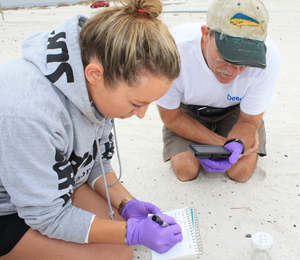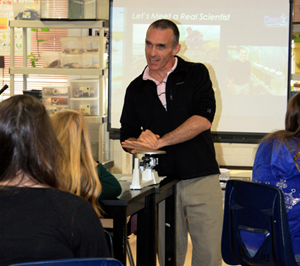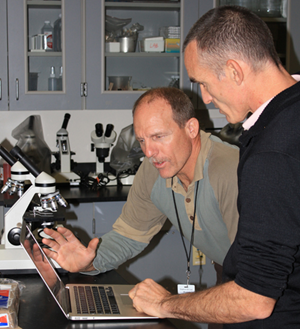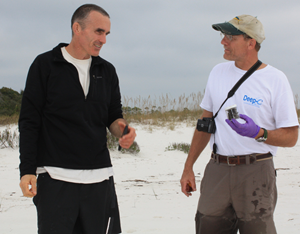
Catherine Carmichael, a research associate at WHOI, shows teacher Shawn Walker that taking detailed notes is essential when collecting data. (Photo by Danielle Groenen)
Talk about compounding interest! Put together scientists and teachers who are passionate about their work with students who are eager to help with ongoing research and watch as excitement fuels student engagement, sparks career interest, and feeds enthusiasm of all. And as a side bonus, research is conducted more efficiently in both time and cost. That’s a pretty good return on investment.
Some Florida high school students have been given an opportunity to engage in hands-on research that is as meaningful as it is fun thanks to a new initiative called Project Gulf Oil Observations (GOO). Members of the research consortium Deep Sea to Coast Connectivity in the Eastern Gulf of Mexico (Deep-C) developed Project GOO which trains teachers and students to be effective citizen scientists and puts their new-found knowledge into use during visits to Gulf beaches in search of oil patties. Deep-C studies the long-term fate and effects of petroleum hydrocarbons in the Gulf.

Chris Reddy deconstructs the stereotypes associated with scientists. (Photo by Danielle Groenen)
“I cannot think of better vehicles to engage students than getting their hands dirty and learning how the world, in particular the ocean, works,” said Dr. Christopher Reddy, a Woods Hole Oceanographic Institution (WHOI) marine chemist and scientist with Deep-C.
In November 2013, Deep-C representatives Amelia Vaughan and Danielle Groenen accompanied Reddy and his research associate Catherine Carmichael to West Florida High School of Advanced Technology to work with Shawn Walker, a Marine Science teacher. The Deep-C group brought action-packed lesson plans that engaged and motivated students, which Walker very much appreciated: “Their hands-on lab activities, video presentations, relevant articles, and direct instructional approaches showed significant pre-planning and organizational skills. More important, was their genuine desire to make a positive and lasting impression on the students they are working with.” The next day, the team went into the field with Walker to train him in their methods.
Calling himself “very much an outsider to the Gulf,” Reddy was pleased to find Walker not only “talented and enthusiastic,” but also possessed of an extensive knowledge of the area’s geography and coastal processes, both invaluable to the project. Explaining the significance of Walker’s local knowledge base, Reddy said, “This will play a big role when we want to ‘tell a story’ on the oiled samples that Shawn and his students collect. Being able to say ‘there are more oiled-samples here because the tides/currents are stronger’ will provide a richer context to learning how spilled oil behaves.”

High school teacher Shawn Walker and Chris Reddy of WHOI are deep in discussion about sample analysis. (Photo by Danielle Groenen)
Walker also was very pleased, “Chris presented himself with humor to a classroom full of aspiring marine science students and, in a very informal and straightforward manner, he talked about what it takes to become a scientist, his successes and failures, and what motivated him along the way.” Walker described Chris and his presentation as a “home run” with the students because “he took off the ‘cloak of invisibility’ with his personal appearance. After all, how many research scientists have been in your classroom lately?”
In late February, Walker will take two of his classes to Gulf-front sites in the area to collect samples and mail them to the Reddy lab at WHOI for analysis. The Deep-C GOO coordinators are excited to be working with their first group of students. Over the next five months, these “GOOies” will receive on-site instruction and special training. The lesson plans and hands-on activities meet Florida’s educational standards and touch on general ocean science and oil spill research, oil degradation, how to think like a scientist, and the correct way to conduct scientific sampling.
The first phase of Project GOO was so successful that Deep-C plans to broaden it to include a school in Tallahassee at the end of March, adding Dr. Olivia Mason from Florida State University to the team for her expertise in oil analysis.

Teacher Shawn Walker and scientist Chris Reddy reflect on a hard day’s work at the beach! (Photo by Danielle Groenen)
Reddy, a specialist on following oil as it passes through the environment, has been making frequent trips to the Gulf Coast from Massachusetts to collect samples since the Deepwater Horizon oil spill in 2010. Even though the oil spill occurred more than three years ago, the process of gathering and analyzing information about the fate of the oil and dispersants will take years. The continuation of Project GOO will be a cost-effective way to get Reddy the data he needs and engage local young people in relevant, hands-on scientific work that affects them directly. Reddy summed up the citizen scientist initiative by saying, “Field work is fun, rewarding, and is an excellent teaching tool. Students and their parents need to know that you don’t need a degree in science to contribute.”
Engaging younger students is equally important to the project. At WHOI, Reddy works exclusively with graduate students. He called working with high school students “a real treat” and stressed the importance of getting young people “hooked” on science before they begin college and make choices that will affect their own life’s path and the future of scientific research as a whole.
Walker’s enthusiasm for this program is palatable: “In my opinion the highly respected, professional resources provided through contact with the Deep-C consortium make them one of the most sought after educational partners of the decade!”
Watch this video of students at West Florida High School as they learn to “Think Like a Scientist” as part of Project GOO:
This research was made possible in part by a grant from BP/The Gulf of Mexico Research Initiative (GoMRI) to theDeepsea to Coast Connectivity in the Eastern Gulf of Mexico (DEEP-C) consortium. The GoMRI is a 10-year independent research program established to study the effect, and the potential associated impact, of hydrocarbon releases on the environment and public health, as well as to develop improved spill mitigation, oil detection, characterization and remediation technologies. An independent and academic 20-member Research Board makes the funding and research direction decisions to ensure the intellectual quality, effectiveness and academic independence of the GoMRI research. All research data, findings and publications will be made publicly available. The program was established through a $500 million financial commitment from BP. For more information, visit http://gulfresearchinitiative.org/.
